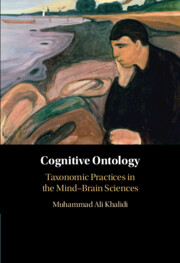Book contents
- Cognitive Ontology
- Cognitive Ontology
- Copyright page
- Dedication
- Contents
- Figures
- Contributors
- Preface
- Chapter 1 Cognitive Kinds
- Chapter 2 Concepts
- Chapter 3 Innateness
- Chapter 4 Domain Specificity
- Chapter 5 Episodic Memory
- Chapter 6 Language-Thought Processes
- Chapter 7 Cognitive Heuristics and Biases
- Chapter 8 Body Dysmorphic Disorder
- Chapter 9 Epilogue
- References
- Index
Chapter 7 - Cognitive Heuristics and Biases
Published online by Cambridge University Press: 15 January 2023
- Cognitive Ontology
- Cognitive Ontology
- Copyright page
- Dedication
- Contents
- Figures
- Contributors
- Preface
- Chapter 1 Cognitive Kinds
- Chapter 2 Concepts
- Chapter 3 Innateness
- Chapter 4 Domain Specificity
- Chapter 5 Episodic Memory
- Chapter 6 Language-Thought Processes
- Chapter 7 Cognitive Heuristics and Biases
- Chapter 8 Body Dysmorphic Disorder
- Chapter 9 Epilogue
- References
- Index
Summary
This chapter discusses the categories of cognitive heuristic and cognitive bias. These categories have come to define a burgeoning research program in cognitive science (the “heuristics and biases” program) and are widely considered to be universal features of human thought. On closer inspection, both categories are found to be too heterogeneous to identify real cognitive kinds, though some of their sub-categories may. In particular, the chapter examines the construct myside heuristic (closely related to the phenomenon often known as “confirmation bias”). This is found to be a better candidate for being a cognitive kind, since it seems to pertain to a specific feature of human cognitive architecture. Moreover, the myside heuristic, which (roughly speaking) attaches more weight to one’s own opinions than to contrary opinions, can be rational in certain contexts. Thus, distinguishing the heuristic from a corresponding bias can only be done against the background of a cognitive task or problem. This constitutes another instance of contextual or environmental individuation of a cognitive construct, making it unlikely that it will correspond to a neural kind.
- Type
- Chapter
- Information
- Cognitive OntologyTaxonomic Practices in the Mind-Brain Sciences, pp. 181 - 209Publisher: Cambridge University PressPrint publication year: 2023

